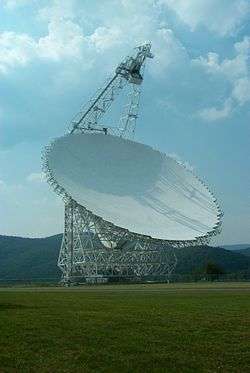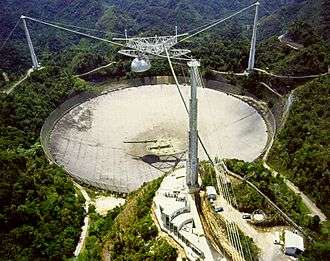Radio astronomy service




Radio astronomy service (also: radio astronomy radiocommunication service) is – according to Article 1.58 of the International Telecommunication Union´s (ITU) Radio Regulations (RR)[1] – defined as «A radiocommunication service involving the use of radio astronomy.» Subject of this radiocommunication service is to receive radio waves transmitte by astronomical or celestical objects.
- See also
- Main articles: Radio station and Radiocommunication service
Frequency allocation
The allocation of radio frequencies is provided according to Article 5 of the ITU Radio Regulations (edition 2012).[2]
In order to improve harmonisation in spectrum utilisation, the majority of service-allocations stipulated in this document were incorporated in national Tables of Frequency Allocations and Utilisations which is with-in the responsibility of the appropriate national administration. The allocation might be primary, secondary, exclusive, and shared.
- primary allocation: is indicated by writing in capital letters (see example below)
- secondary allocation: is indicated by small letters
- exclusive or shared utilization: is within the responsibility of administrations
In line to the appropriate ITU Region the frequency bands are allocated (primary or secondary) to the radio astronomy service as follows.
Frequency bands
| Allocation to services | ||
| Region 1 | Region 2 | Region 3 |
13 360–13 410 kHz FIXED
| ||
| 25 550–25 650 RADIO ASTRONOMY | ||
37.5–38.25 MHz FIXED
| ||
322–328.6 FIXED
| ||
406.1–410 FIXED
| ||
1 400–1 427 EARTH EXPLORATION-SATELLITE (passive)
| ||
| 1 610.6–1 613.8 MOBILE-SATELLITE
RADIO ASTRONOMY
|
1 610.6–1 613.8 MOBILE-SATELLITE
RADIO ASTRONOMY
RADIODETERMINATION-
|
1 610.6–1 613.8 MOBILE-SATELLITE
RADIO ASTRONOMY
Radiodetermination-
|
| 10.6–10.68 GHz RADIO ASTRONOMY and other services | ||
| 10.68–10.7 RADIO ASTRONOMY and other services | ||
| 14.47–14.5 RADIO ASTRONOMY and other services | ||
| 15.35–15.4 RADIO ASTRONOMY and other services | ||
| 22.21–22.5 RADIO ASTRONOMY and other services | ||
| 23.6–24 RADIO ASTRONOMY and other services | ||
| 31.3–31.5 RADIO ASTRONOMY and other services | ||
References / sources
- ↑ ITU Radio Regulations, Section IV. Radio Stations and Systems – Article 1.58, definition: radio astronomy service / radio astronomy radiocommunication service
- ↑ ITU Radio Regulations, CHAPTER II – Frequencies, ARTICLE 5 Frequency allocations, Section IV – Table of Frequency Allocations